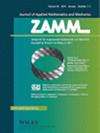Temperature‐dependent electrical conductivity impact on radiative and dissipative peristaltic transport of boron nitride‐ethylene glycol nanofluid through asymmetric channels
IF 3.2
4区 工程技术
Q1 MATHEMATICS, APPLIED
Zamm-zeitschrift Fur Angewandte Mathematik Und Mechanik
Pub Date : 2023-09-05
DOI:10.1002/zamm.202300136
引用次数: 0
Abstract
Mathematical simulation of biological fluids is of upmost significance due to its numerous medical uses. Interpreting various biological flows necessitates a thorough knowledge of the peristaltic mechanism. This paper presents a computational study for the peristaltic pumping within vertical asymmetric channels filled with BN‐EG nanofluid under the influence of temperature‐dependent electrical conductivity and thermal radiation. Experimental study showed that the nanofluid created by suspending Boron Nitride particles in a combination of Ethylene Glycol exhibited non‐Newtonian characteristics. Further, the Carreau's fluid model provides accurate predictions about the rheological properties of BN‐EG nanofluid. Various configurations of the outer boundaries are considered, namely, square wave, multi‐sinusoidal wave, trapezoidal wave, and triangular wave. A uniform magnetic field together with nanoparticles and mass concentrations, joule heating, first‐order chemical reaction as well as viscous dissipation are considered. Influences of the Dufour and Soret numbers are examined, and the cases of biological scientific assumptions which is known as low Reynolds number and long wavelength are applied. All the computations are obtained numerically using Mathematica symbolical software (ND‐Solve), and the obtained results are presented in terms of the axial velocity u, heat transfer rate Z, concentration profile Ω, temperature profile θ, extra stress tensor , pressure gradient , pressure rise and stream function ψ. The major outcomes revealed that the maximizing in electrical conductivity coefficient, variable viscosity coefficient and magnetic field parameter is better to obtain a higher rate of the heat transfer while the increase in thermo‐diffusion effects as well as linear thermal radiation coefficient causes a reduction in the rate of heat transfer.温度依赖性电导率对氮化硼-乙二醇纳米流体通过不对称通道的辐射和耗散蠕动传输的影响
生物流体的数学模拟由于其众多的医学用途而具有最重要的意义。解释各种生物流动需要对蠕动机制有透彻的了解。本文研究了在温度相关电导率和热辐射影响下,BN - EG纳米流体填充的垂直不对称通道内的蠕动泵送。实验研究表明,将氮化硼颗粒悬浮在乙二醇混合物中产生的纳米流体具有非牛顿特性。此外,carcarau的流体模型提供了对BN - EG纳米流体流变特性的准确预测。考虑了外部边界的各种构型,即方波、多正弦波、梯形波和三角波。考虑了均匀磁场、纳米粒子和质量浓度、焦耳加热、一阶化学反应以及粘性耗散。研究了Dufour数和Soret数的影响,并应用了低雷诺数和长波长的生物科学假设。利用Mathematica符号软件(ND‐Solve)进行了数值计算,得到了轴向速度u、换热率Z、浓度曲线Ω、温度曲线θ、额外应力张量、压力梯度、压力升和流函数ψ的计算结果。主要结果表明:电导率系数、变黏度系数和磁场参数的最大化有利于获得较高的换热速率,而热扩散效应和线性热辐射系数的增加会导致换热速率的降低。
本文章由计算机程序翻译,如有差异,请以英文原文为准。
求助全文
约1分钟内获得全文
求助全文
来源期刊
CiteScore
3.30
自引率
8.70%
发文量
199
审稿时长
3.0 months
期刊介绍:
ZAMM is one of the oldest journals in the field of applied mathematics and mechanics and is read by scientists all over the world. The aim and scope of ZAMM is the publication of new results and review articles and information on applied mathematics (mainly numerical mathematics and various applications of analysis, in particular numerical aspects of differential and integral equations), on the entire field of theoretical and applied mechanics (solid mechanics, fluid mechanics, thermodynamics). ZAMM is also open to essential contributions on mathematics in industrial applications.

 求助内容:
求助内容: 应助结果提醒方式:
应助结果提醒方式:


